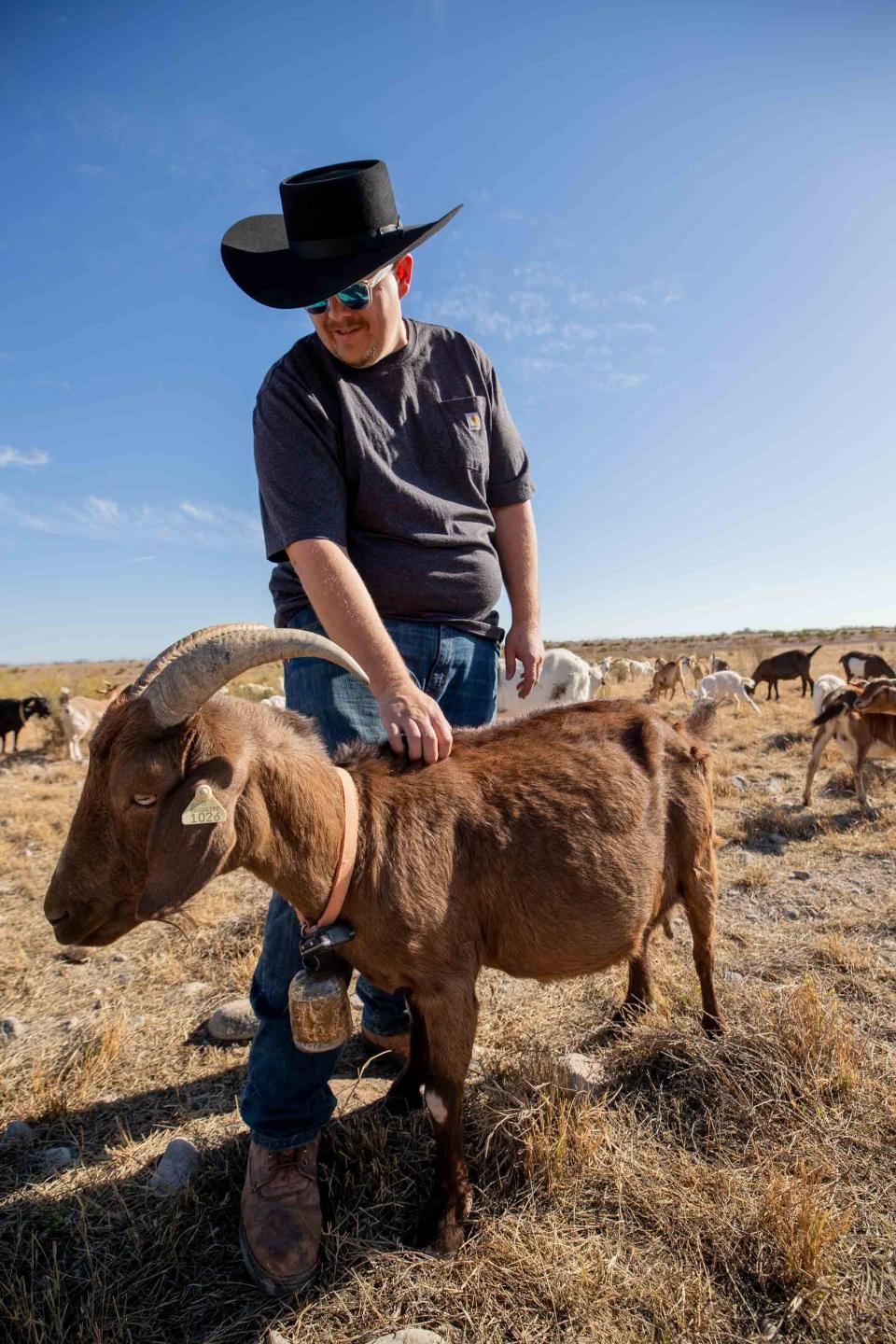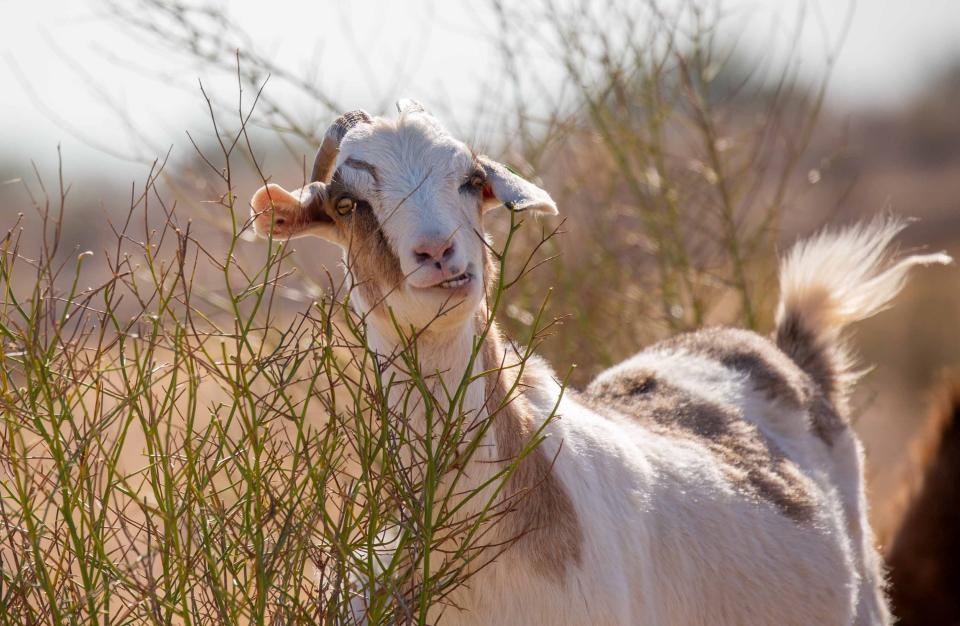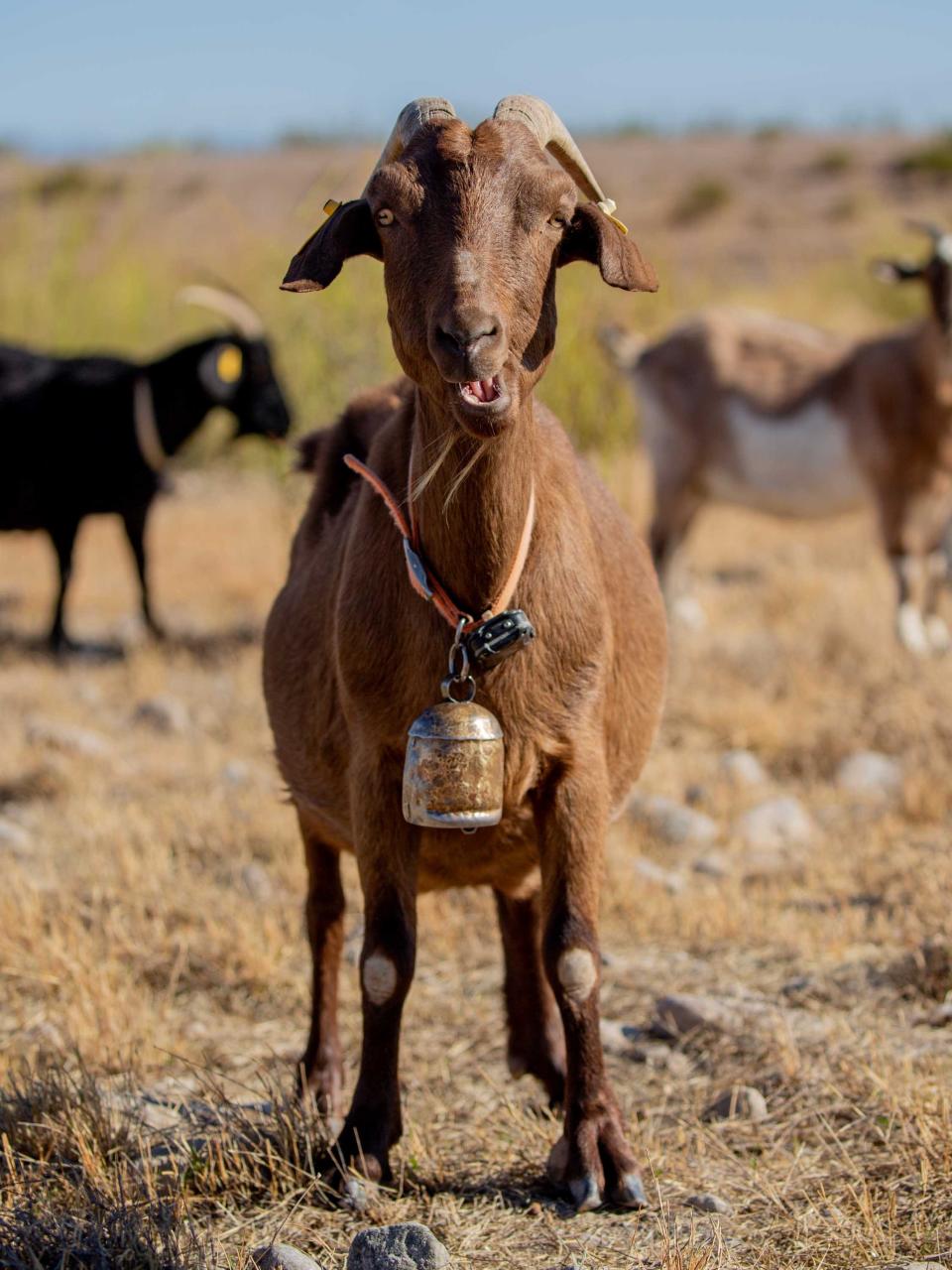When vegetation choked off water recharge basins, who did CAP call? Goat munchers
Corrections & Clarifications: A previous version of this story misidentified San Tan Valley.
In an overgrown and dried-up basin outside San Tan Valley, ringing bells and the occasional cacophony of goat bleats have replaced the sound of water flowing into the area.
The source of the sound is a herd of 70 goats that have taken up residence, munching away at the dense vegetation with an appetite and a purpose: protect critical water infrastructure.
The Central Arizona Water Conservation District — the agency that delivers Colorado River water to Phoenix and Tucson through the Central Arizona Project Canal — usually fills its Superstition Mountains recharge basins with excess water for future use. But over the past few months, the district has flooded one basin with goats.
Since CAP reduced water pumping over the last two years amid drought restrictions, a thicket of vegetation had taken over the two 20-acre basins. Bermuda grass, salt cedar, creosote bush and small mesquites have moved in, choking water infiltration.
When water flows into the basins, it typically absorbs steadily through the soil into the aquifer below. More recently, the water has pooled across the entirety of the basins, the infiltration rate slowed because of the grasses and trees poking out of the water.
“When the basins get inundated with vegetation, it limits the amount of water we can infiltrate into the ground,” said Phillip Pagels, a water transmission supervisor for CAP.
The second basin had a similar weed infestation, until CAP hired the herd of goats to unleash their hardy hunger.
The foragers have feasted on the overgrowth since October, clearing most of the vegetation to reveal the rocky soil ideal for absorbing surplus allowances from the Colorado River into the aquifer.

CAP officials are happy with the results so far. Removing the vegetation will improve absorption rates, allowing faster drainage.
“Rather than mechanically coming in, which isn’t perfect and is expensive, or spraying, which wouldn’t be something you want to do in a recharge basin, this was our innovative solution to weed control,” said DeEtte Person, a communications strategist at CAP.
Managers plan to relocate the goats to the untreated basin in January and hope to continue this unique land management technique in the five other recharge basins across the state with similar vegetation problems.
How do recharge basins work?
Arizona could not store its surplus water allowance from the Colorado River before the recharge basins were added to the system. The CAP had to leave excess water in the river, meaning the state did not receive all the water it was entitled to annually.
In 1996, CAP began recharging water to ensure Arizona could access its entire allowance and plan for future shortages.
Recharge is a water management technique that stores water underground. Water is pumped from the CAP canals into the basins, allowing it to percolate through the soil, replenish aquifers and boost groundwater supplies.
Each year, CAP schedules flows into recharge basins. This provides a regional opportunity for municipalities and those with access to the Colorado River to store water for use at a later date using long-term storage credits.

After CAP deposits water into the aquifer, cities can pump water from recovery wells when they need it. As Colorado River allowances are stretched thin across the seven states relying on it, the agency says a dependable water infrastructure is more important than ever.
Beyond saving surplus, recharging water improves water quality through natural filtration, prevents land subsidence — a phenomenon that causes the ground to sink from excess groundwater pumping — and limits intrusion of water heavy with salts and other minerals.
The Superstition Mountains basins hold 56,500 acre-feet of water, part of a larger network of six CAP basins that can store about 200,000 acre-feet. One acre-foot can provide water for three average-sized families — about three or four people — for a year.
As water levels decline in the Colorado River from overuse and a historic drought, CAP has had less water to pump into the basins, creating the perfect scenario for weeds and vegetation to grow.
“When you turn it on for a few weeks then shut it off, that’s the worst thing you can do in a recharge project,” said Al Grochowski, a water systems control technician at CAP. “The vegetation starts to grow and it gets above the water, and you can’t drown it.”
Taking care of the land: On the Bush Fire scar, volunteers have begun restoring the desert, one saguaro at a time
Why CAP brought in goats to clear vegetation
After CAP managers noticed water infiltration had stalled in the Superstition Mountains basins due to weed buildup, they needed to find an inexpensive solution that would not endanger water quality.
CAP previously used goats to clear vegetation in the 2000s, but shifted to other methods when they couldn't find a goat herder.
Bryant Dickens, a water resources field engineer for CAP, was assigned to find a new herd of goats to take care of the weed problem.
“It wasn’t easy. I was looking all over the West Coast,” Dickens said. “I stumbled upon Reece on Facebook, gave him a call and it worked out well for us.”

Reece Bickerdyke is a self-proclaimed goat wrangler, calling his goats his “pride and joy.” He owns Rockin’ AR Goats, specializing in organic weed removal. Before his latest gig with CAP, his goats would help land managers clear vegetation from mountain lands and private property.
He owns Kiko goats, a low-maintenance breed originating in New Zealand. They live well in arid, rocky and mountainous regions, making them an ideal breed to raise in Arizona.
The herd will live in the basin for the entirety of the project under Bickerdyke’s supervision and only require drinking water as their plant diet is well supplied in the basin. He expects to expand his fleet of foragers to about 200 goats following the winter breeding season.
Kiko goats eat most plants available to them, including grass, hay and weeds. According to Bickerdyke, their extensive diet does not mean they aren’t picky eaters.
“They do what I call the cake, steak, salad method. They eat what they want first and pick it out of the whole area,” Bickerdyke said, “And while being lazy.”
To avoid hiking across the 20-acre basin to quench their thirst between snacks, the goats first cleared the vegetation closest to the water basins, targeting their favorite plants along the way.
As the project nears completion, Bickerdyke said the vegetation remaining is the “iceberg salad,” the least desirable shrubs and grasses furthest from the water troughs.
Subscribe to AZ Climate: The Republic's environment newsletter brings you stories like this one to your mailbox every Tuesday.
An innovative land management technique
As the West struggles with frequent wildfires fueled by highly-flammable grasses and low-lying vegetation, Bickerdyke believes goats are an overlooked solution in land management.
Land managers rush to clear fuels before fires do, and Bickerdyke says goats are cheaper than mechanical clearing, safer than chemical treatments and can traverse mountainous landscapes that would be difficult to reach.
Using goats in the Superstition Mountains basins was significantly cheaper than alternative treatments.
“We got quotes that were flat-out shocking for the mechanical removal,” Dickens said, referring to the treatment that was four times more expensive than the goats.
When CAP resumes pumping in January, Dickens believes infiltration rates will be “phenomenal.” The basins currently infiltrates four acre-feet per day, but officials expect a 20 to 30% increase when the goat project ends.
This increase would allow CAP to recharge as much as 3,100 acre-feet per month, compared to its current rate of 2,400 acre-feet.
The only downside to using a goat herd for vegetation removal is it takes longer than other solutions. Since the Superstition basins pump less water recently, CAP can pause operations on one basin at a time to let the goats work.
Managers plan to use aerial drone images to track the goat’s productivity from October to January, along with several game cameras that take time lapses every day.
The difference between the treated and untreated basins is already obvious, and CAP hopes to continue using Bickerdyke’s goats throughout its basin system.
“As land managers, you have to understand what the tools are in your belt,” Bickerdyke said, “Some people have looked at goats as a novelty and not actually a viable option. In certain situations, they are the best choice.”
Hayleigh Evans covers environmental issues for The Arizona Republic and azcentral. Send tips or questions to hayleigh.evans@arizonarepublic.com.
Environmental coverage on azcentral.com and in The Arizona Republic is supported by a grant from the Nina Mason Pulliam Charitable Trust. Sign up for AZ Climate, our weekly environment newsletter, and follow The Republic environmental reporting team at environment.azcentral.com and @azcenvironment on Facebook, X and Instagram.
You can support environmental journalism in Arizona by subscribing to azcentral today.
This article originally appeared on Arizona Republic: CAP sends in the goats to clear weeds from water recharge basins

